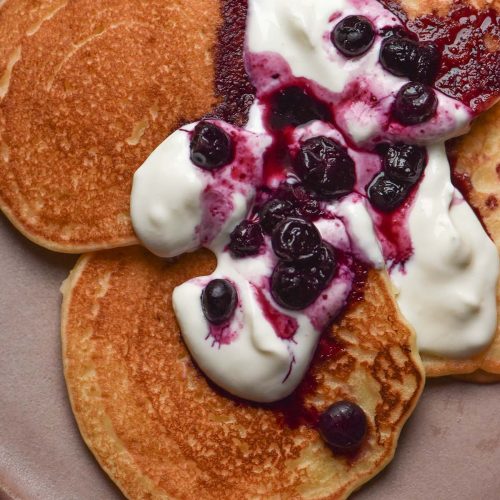
Gluten free dairy free pancakes
Nut free option, xanthan gum free option, low FODMAP *Cups and tablespoons are in Australian cups and tablespoons. Use ml for international accuracy. Australian tablespoons are 20ml as opposed to the more common 15ml. If you use 15ml tablespoons, use 2 1/2 tablespoons oil for these pancakes. Australian teaspoons are 5ml which is roughly on par with most places.
Ingredients
Dry ingredients:
- 175 g fine white rice flour
- 25 g tapioca flour/starch (see notes)
- 1.5-3 g (1/4 - 1/2 teaspoon) baking powder (see notes)
- Good pinch fine salt
- Good grating lemon zest (optional)
Wet ingredients:
- 300-350 g plain coconut yoghurt (see notes)
- 50-75 g white sugar (see notes)
- 40ml (2 tablespoons)* neutral oil of choice
- 2 extra large eggs (45-55g, weighed out of shell)
To finish:
- 60-125 ml (1/4 - 1/2 cup)* plant based milk, only as needed
- Dash of vanilla extract or paste (optional but recommended)
Instructions
- Whisk together the flours, baking powder and optional lemon zest in a medium mixing bowl.
- Whisk together the wet ingredients (except for the milk and vanilla) in a medium mixing bowl.
- Pour the wet mixture into the dry ingredients. Whisk to combine, then assess your batter. The ideal consistency for these pancakes is just spoonable. The batter should not be so thick that it doesn’t drizzle off the spoon. However, it also shouldn’t be too runny that it doesn’t stay on the spoon. I like to spoon the batter into the pan, then have the ability to spread it with ease into the shape I want without it spreading much by itself. That is the consistency I aim for.
- Add milk to reach this consistency (if you need to) and the vanilla, if you are using it. Only add milk if you need it – see notes in the body of the post.
- Heat a good quality pan thoroughly over a medium heat. Once thoroughly heated, turn the heat down and add a small amount of oil or butter. Spoon around 2 generous tablespoons of batter into the pan and use a spoon to spread it to your desired shape.
- Cook until the top is bubbling, then flip and cook 2-3 minutes longer or until cooked through. The centre of the pancake should feel solid and not yielding if you press it with your finger. Adjust the heat based on the first pancake before cooking the rest of the pancakes.
- I generally get about 8-10 pancakes per batch using 2 tablespoons of batter per pancake. I find you no longer need to add butter or oil (if you don't want to) after the first few pancakes provided the pan has reached the right heat.
- Serve immediately with toppings of your choice. Leftovers keep well in an airtight container in the fridge.
Notes
- How much milk you add (if you need to add any) is really dependent on the yoghurt you use and how absorbent your rice flour is. You need to assess your batter as per the description of how thick the batter should be and add milk accordingly.
- How much sugar you add depends on the yoghurt you use and how sweet it is.
- If you have a strong tasting coconut yoghurt and don't want to taste 'coconut' you can use 300g as opposed to 350g.
- You cannot use coconut milk or cream in place of yoghurt.
- If you like a slightly fluffier pancake, you can use 1/2 teaspoon (3g) baking powder as opposed to 1/4 teaspoon (1.5g).
- I have not tested an egg free or sugar free version of these pancakes.
- See the body of the post for tips on the ideal consistency for your batter.
Tried this recipe?Let us know how it was!